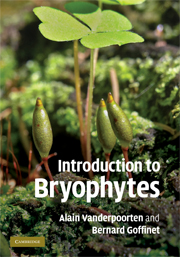3 - Liverworts
Published online by Cambridge University Press: 05 June 2012
Summary
The common ancestor to the Marchantiophyta arose immediately after the conquest of land, some 450 mya. Their evolutionary history is, however, also characterized by a more recent diversification during the early Tertiary Period. This diversification may coincide with the establishment of modern rainforests and resulted in species rich crown groups such as the Lejeuneaceae (Heinrichs et al. 2007). With approximately 5000 extant species currently recognized, liverworts compose a diverse lineage of land plants, represented on every continent and in nearly all ecosystems. Some species are virtually invisible to the naked eye, whereas others rival mosses in their stature. Although the experienced eye may easily distinguish liverworts from other bryophytes in the wild, not a single conspicuous unifying morphological vegetative character defines them. The architecture of the gametophyte varies from thallose, with or without internal differentiation, to leafy, with leaves divided in some lineages into two or more lobes. It is only after sexual reproduction is completed that liverworts reveal their shared ancestry: the sporangium is enclosed by an epidermis lacking stomata and elevated above the maternal protective tissue on a translucent seta that elongates after sporogenesis. Furthermore, the capsule lacks a columella and the sterile cells within the sporangium develop into elaters. Except for the Blasiales, liverworts lack endophytic cyanobacteria, but most species establish symbiotic associations with mycorrhizal fungi. Although inconspicuous at the landscape level, liverworts form diverse assemblages in moist habitats such as temperate and tropical rainforests, where they thrive on trunks and leaves.
- Type
- Chapter
- Information
- Introduction to Bryophytes , pp. 43 - 69Publisher: Cambridge University PressPrint publication year: 2009



